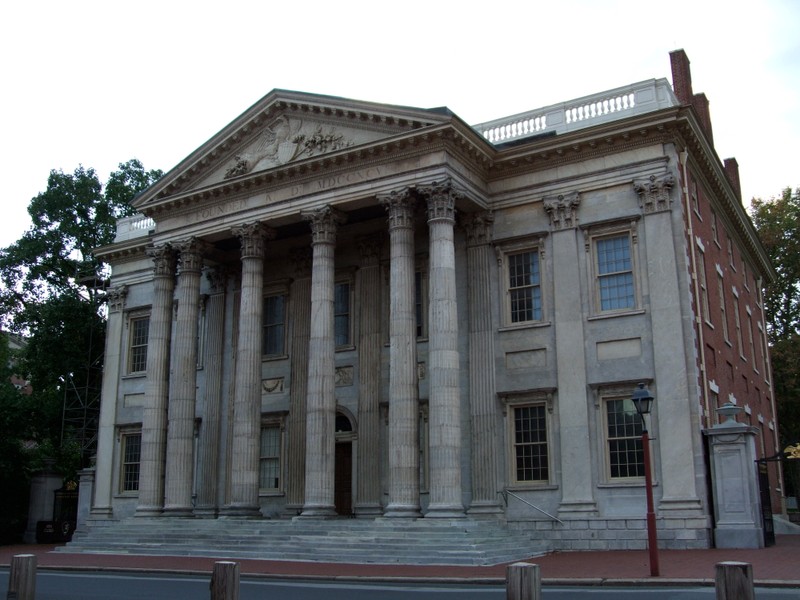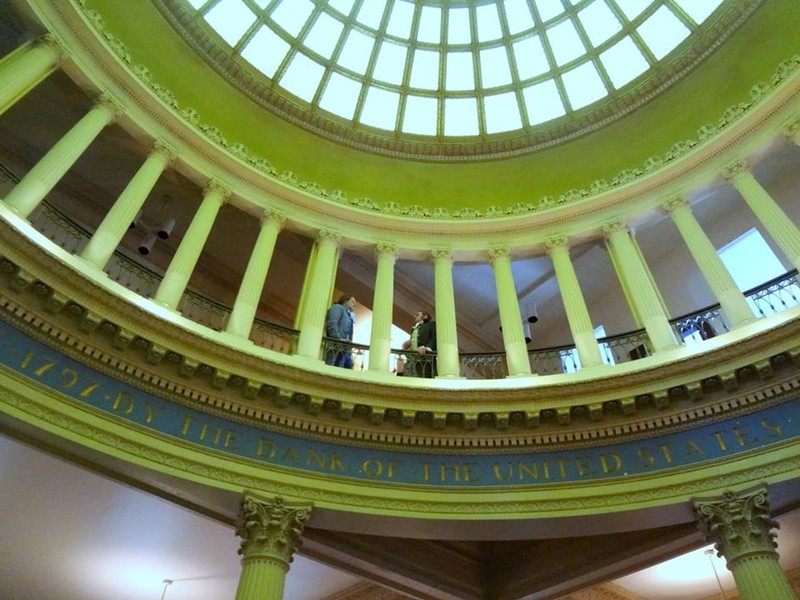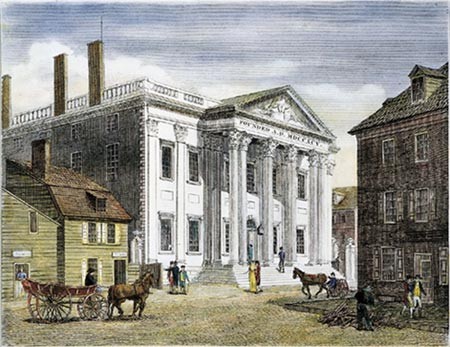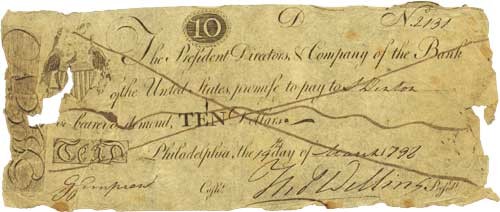First Bank of the United States
Introduction
Text-to-speech Audio
Images
The First Bank of the United States

Period actors dressed as Hamilton and Jefferson in the bank's rotunda.

A drawing of the bank during the days of the horse and carriage.

A bank note from the First Bank of the U.S.

Backstory and Context
Text-to-speech Audio
The First Bank of the United States was chartered when President George Washington signed the Bank Bill in February of 1791. However, its creation was no forgone conclusion as then Secretary of State, Thomas Jefferson, led the opposition to its formation. The idea for a national bank was put forth by Secretary of the Treasury, Alexander Hamilton, as a means to secure the country’s financial well-being after the Revolutionary War and the failed Articles of Confederation. Hamilton believed the bank would achieve several necessary goals, to include establishing the secure credit of the United States, the paying off of federal and state Revolutionary War debts, the creation of a national currency, and as a means to raise and store money for the federal government.
The arguments for and against the creation of the bank essentially boiled down to whether or not it was permitted under the federal government’s new framing document, the Constitution. Jefferson, who feared the power of a strong, centralized government and favored the continued existence of state banks, offered a strict interpretation of the Constitution. In this instance, he claimed that what the Constitution does not expressly allow, it prohibits. Hamilton, in the other hand, chose to interpret the Constitution in a loose manner. He claimed that what the Constitution does not expressly forbid, it allows, now known as the “implied powers” of the Constitution. As evidenced by what you’re reading, Hamilton’s argument swayed both houses of Congress and President Washington and the bank was created with a twenty-year charter.
It was initially housed in Carpenters’ Hall and then was transferred to the new bank building in 1797. After the bank was not re-chartered, the building was purchased by Philadelphia business magnate Stephen Girard in 1812, who then operated his own bank from the premises. Before he bought the bank’s property, Girard was a strong advocate for the First Bank’s renewal, being its top individual shareholder shortly before the charter expired. The institution that Girard created and financed was a private unincorporated bank. Pennsylvania banks established by a group of people were required to be incorporated, but as the wealthiest American of his time Girard was able to exploit this legal loophole by maintaining sole ownership of the bank. Rival banks across the state felt threatened by the immediate success of this new competitor. They challenged the legality of Girard’s enterprise on several occasions, and refused to honor his bank’s notes when presented by customers.
The War of 1812 erupted only shortly after the bank opened and in 1813 the federal government appealed to citizens of the young republic for a war loan of 16 million dollars. When subscriptions from the American public raised only half the necessary funds, Girard committed to fulfilling the rest of the crucial loan. He loaned 2.5 million dollars of his own fortune and found subscribers for the remainder, as investors were reassured by his confidence and example. In return, he requested that the Treasury deposit the loan money in his bank, adding legitimacy and reserves to the new bank. He also received a ¼ % commission on the subscriptions he arranged, an investment banking innovation. Later on, Girard's Bank would go on to arrange loans to the state legislature and even to President James Monroe.
Stephen Girard, sole proprietor of Stephen Girard’s Bank, died in 1831. Girard Bank, a new incorporated and independently-run institution, later rented the building from Stephen Girard’s estate. The interior was remodeled in 1902 and Girard Bank moved its operations from the bank building in 1929. It was then acquired by the Independence National Historic Park in 1955 and was renovated in 1976. It served as a temporary visitor’s center in 1967, then as the park’s headquarters until they moved to the Merchants’ Exchange Building in 2000. Plans were underway to convert it into a Philadelphia Civil War museum, but it failed to gain the necessary state funding.
Sources
"First Bank of the United States." Independence National Historical Park." Accessed December 20, 2016. https://www.nps.gov/inde/learn/historyculture/places-firstbank.htm
Hill, Andrew. "The First Bank of the United States: 1791-1811." Federal Reserve History. December 4, 2015. Accessed December 20, 2016. http://www.federalreservehistory.org/Events/DetailView/94
Fansler, Jordan. "Bank of the United States (First)." Encyclopedia of Greater Philadelphia. 2016. Accessed December 20, 2016. http://philadelphiaencyclopedia.org/archive/bank-of-the-united-states-first/
Cowan, David. "The First Bank of the United States." Economic History Services. Accessed December 20, 2016. https://eh.net/encyclopedia/the-first-bank-of-the-united-states/
Simpson, Stephen. Biography of Stephen Girard, with His Will Affixed. Philadelphia, PA. T. L. Bonsal, 1832.
Wilson, George. Stephen Girard: The Life and Times of America's First Tycoon. Signpost Biography Series. Conshohocken, PA. Combined Publishing, 1995.
